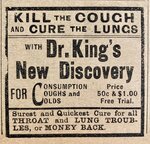








Seek you a cure
easy and sure
For aching sprains
or hurts or pains,
Of every sort,
in any part.
Be of good cheer,
the secret’s here:
And if you heed
what here you read,
Your pains you’ll end,
your ailments foil;
For you will send
for “ST. JACOB’S OIL.”
In the early 1900’s you could find advertisements for St. Jacob’s Oil painted on
barns, fences, rocks, and in the West Concord Enterprise. It was promoted to cure
rheumatism, neuralgia, gout and “all other aches and pains”. St. Jacob’s Oil was a
topical made from alcohol, camphor, ether, carbolic acid, capsicum and aconite (a toxic
plant). There were no “truth in advertising” laws yet. Ingredients did not have to be listed and patent medicines were abundant. Their promises were too good to be true.
I spent one very interesting morning at the Museum skimming W. C. Enterprises
from 1904, taking a closer look at the patent medicines that were advertised. When I
got home I researched some of them.
One of the most widely advertised medicines was Peruna, the Great Tonic. Its influence was so vast that babies were even named after it. As was the case with many of the patent medicines, its inventor, Sam Hartman, was a skilled advertiser. He was able to enlist the help of hundreds of politicians who endorsed Peruna. Made of 28% alcohol, water, flavoring, and burnt sugar for color, people would first take it as a medicine, then as a beverage, and eventually some would suffer an addiction habit.
It was sold for the condition called catarrh, which we know as cold, flu, allergy, or sinusitis symptoms.
Three of the medicines promoted in the Enterprise were for the treatment of tuberculosis, or as it was called then, consumption, because people simply
wasted away with the disease. Use of the medicines likely shortened the lives of patients because of the ingredients. Dr. King’s New Discovery for Consumption had three active ingredients: chloroform to cure coughing, morphine for relief and euphoria, and alcohol to dull the pain. Piso’s Cure for Consumption was the ultimate in quackery.
Invented around the time of the Civil War by a “marketer, a medic, and a moneybags”, its ingredients were chloroform, cannabis, opium, and alcohol. Piso’s sold medicine until World War II. Scott’s Emulsion for Consumption was not nearly as dangerous
as the other two products. It was comprised of cod liver oil and lime soda. It did provide vitamins A and D, but did nothing to help tuberculosis.
Mother Gray’s Sweet Powders for Children were advertised to be as “harmless as milk” for treating pinworms, headache, fever, teething, and constipation in the little ones.
It cost 25 cents and was available “over the counter” at local drug stores. West Concord’s druggists at the time, Elledge & Straight, likely would have carried it. Its main ingredients for constipation were mercurous chloride, which could cause mercury poisoning, and mandrake which was also poisonous and had been sometimes used as a method of suicide. The other ingredients: licorice, slippery elm, anise, soda, sulfur, and sugar were the “sweet” powders.
At the Museum we have a glass bottle labeled Dr. Kennedy’s Rheumatic Dissolvement. Dr. Kennedy was not a doctor but was a great promoter of his product made of roots and herbs, steeped in water and alcohol. In fact, his concoction was 42% alcohol! He recommended drinking one bottle for skin problems and two to five bottles to cure the worst rheumatism imaginable. He recommended adding a little honey for sweetener.
Dr. Williams’ Pink Pills for Pale People captured my imagination. It was an iron rich
tonic that actually could help people with anemia, but its claims were more than a bit exaggerated. The pink pills were advertised to cure anything from depression to paralysis.
Losing your hair? Hall’s Vegetable Sicilian Hair Renewer might be just what you need. Made of water, glycerin, herbs, lead, and rum—who knows what might happen?
If Hall’s didn’t work, you could try Ayer’s Hair Vigor whose claim was mighty confusing.
It “restored hair to its natural vitality and color but did not “color” the hair”. Hmmmm.
Fortunately in 1906, The Pure Food and Drug Act reined in some of the quackery of
the time. Dangerous ingredients had to be listed and labels could no longer be false or
misleading. Many of the products changed their advertising from promoting “cures” to
marketing “remedies” instead. The Food and Drug Administration (FDA) was born out of the 1906 Act to ensure that the law was followed.
In 1898 the Bayer company began to market a cough remedy for children called Heroin. Yes, you read that correctly. They sold it through the first decade of the 20th century. We can be glad that through the years our government has enacted so many
consumer protection laws. Without them, medical quackery might still reign.
We’d love to have you stop by the Museum and see some of our old medicine bottles and containers. There’s a story to be told with each one.